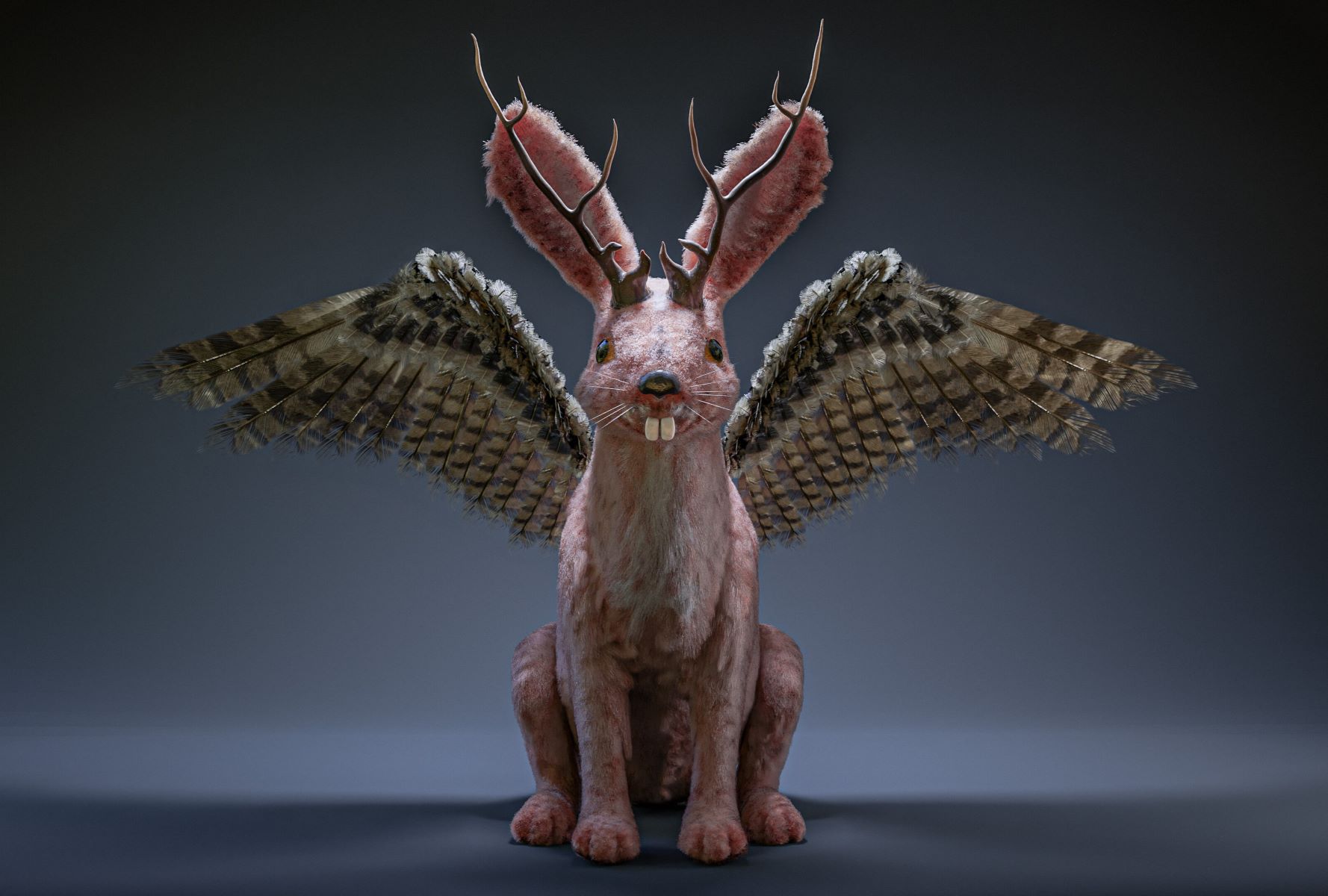
Have you ever heard of the Wolpertinger? This mythical creature from German folklore is a captivating blend of various forest animals. Imagine a hare with deer antlers, pheasant wings, and a squirrel's tail. Originating in the Bavarian Alps, the Wolpertinger has intrigued locals and tourists for centuries. Bavarian taxidermists in the 19th century popularized these hybrids by crafting stuffed versions to sell to unsuspecting visitors. The Wolpertinger isn't just a quirky legend; it symbolizes the rich cultural heritage and creativity of the region. From museums to pubs, this creature continues to enchant and mystify, making it a beloved part of German folklore.
Key Takeaways:
- The Wolpertinger is a fascinating mythical creature from German folklore, known for its bizarre appearance and cultural significance in Bavaria. It has inspired art, storytelling, and tourist attractions, captivating audiences for centuries.
- The Wolpertinger's unique blend of animal features, romantic origins, and role in taxidermy has made it a beloved symbol of Bavarian folklore, showcasing the region's creativity and imaginative storytelling traditions.
What is a Wolpertinger?
The Wolpertinger is a mythical creature from German folklore, particularly popular in Bavaria. This hybrid animal has fascinated people for centuries with its unique and bizarre appearance. Let's dive into some intriguing facts about this legendary being.
-
Definition and Variations: Known by various names such as Wolperdinger, Woipertinger, Volpertinger, and Walpertinger, the Wolpertinger is often described as a mix of several forest animals, including hares, deer, squirrels, and birds.
-
Origins: The exact origin of the Wolpertinger legend remains a mystery. However, it gained popularity in the 19th century when Bavarian taxidermists began crafting stuffed versions to sell to tourists as examples of "local wildlife".
Physical Characteristics of the Wolpertinger
The Wolpertinger's appearance is as varied as the stories about it. Each depiction adds to the creature's mystique.
-
Physical Description: Typically, the Wolpertinger has the body of a mammal, often a hare or squirrel, with the horns of a deer. It may also feature wings, feet, or a beak from various birds, such as pheasants or ducks.
-
Anatomical Variations: While the most common description includes the head of a rabbit, the body of a squirrel, deer antlers, and pheasant wings and legs, other variations exist. Some Wolpertingers may have the body of a ferret or other small mammals, while others might include additional features like tails and fangs.
Historical Context and Cultural Significance
The Wolpertinger isn't just a creature of legend; it has played a significant role in local culture and tourism.
-
Historical Context: For nearly two centuries, the Wolpertinger legend has been used to deceive tourists in the Alps. Local storytellers claimed these creatures roamed the forests, making them seem like part of the local fauna.
-
Romantic Origins: One romantic tale suggests the Wolpertinger originated from a hare and a roebuck's unlikely union. This story proposes that their offspring bore the body of a hare and the horns of a deer, leading to further hybridizations with other forest creatures.
-
Hybrid Offspring: The legend includes tales of various woodland creatures mating and producing mutant offspring. These pairings include foxes and ducks, pine martens and pheasants, and other unlikely combinations.
Behavior and Habitat
Legends about the Wolpertinger also describe its behavior and preferred living conditions.
-
Behavior and Habitat: According to legend, the Wolpertinger is a shy and frugal animal that inhabits the alpine forests of southern Germany, particularly in Bavaria and Baden-Württemberg. It is said to feast on herbs, roots, and insects found in these forests.
-
Defense Mechanism: If threatened, the Wolpertinger can spray a foul-smelling liquid similar to a skunk, which lingers for seven years.
The Role of Taxidermy
Taxidermy played a crucial role in popularizing the Wolpertinger legend.
-
Taxidermy and Tourism: The rise of taxidermy in the 19th century significantly boosted the Wolpertinger's popularity. Taxidermists created these hybrid creatures for amusement and to deceive tourists.
-
Exhibitions and Displays: The Deutsche Jagd- und Fischereimuseum (German Hunting and Fishing Museum) has a permanent exhibition featuring various Wolpertinger creations, showcasing the creativity and craftsmanship of Bavarian taxidermists.
Counterparts in Other Cultures
The Wolpertinger isn't the only mythical hybrid creature in folklore. Other cultures have their own versions.
-
Counterparts in Other Cultures: The Wolpertinger has counterparts in other cultures, such as the Jackalope in North American folklore and the Skvader in Swedish folklore. These creatures share similarities in their hybrid nature and fantastical appearances.
-
Regional Variations: The spelling and appearance of the Wolpertinger vary across regions. In Bavaria, it is commonly known as Wolpertinger, while in other parts of Germany, it might be referred to as Wolperdinger, Woipertinger, or Volpertinger.
Folkloric Tales and Art
The Wolpertinger has inspired numerous tales and artistic depictions over the years.
-
Mythical Origins: The Wolpertinger's mythical origins are often tied to romantic tales of animal couplings. For example, the mating of a hare and a roebuck is said to have produced the first Wolpertinger.
-
Folkloric Tales: According to legend, only an attractive, single woman or someone accompanied by one can spot a Wolpertinger in its natural habitat. This adds to the creature's mystique and allure.
-
Appearance in Art: The Wolpertinger has been depicted in various forms of art, including paintings and sculptures. One notable example is the painting 'Osterhase' by Albrecht Dürer, later edited to create a Wolpertinger depiction.
Educational and Tourist Value
Despite its fictional nature, the Wolpertinger serves as an educational tool and tourist attraction.
-
Educational Value: The Wolpertinger highlights the creativity and imagination of German folklore, serving as an educational tool for understanding cultural heritage and storytelling traditions.
-
Tourist Attractions: Stuffed Wolpertingers remain a popular tourist attraction in Bavaria. Visitors can find them in pubs, hotels, and restaurants, serving as a reminder of the region's rich folklore.
-
Historical Impact: The creation and sale of these hybrid creatures have contributed to Bavaria's reputation for unique and fascinating folklore.
Modern-Day Significance
The Wolpertinger continues to hold a special place in Bavarian culture today.
-
Modern-Day Significance: The Wolpertinger remains celebrated as a symbol of Bavarian folklore, representing the region's rich cultural heritage and inspiring creativity through storytelling.
-
Folkloric Similarities: The Wolpertinger shares similarities with other folkloric creatures worldwide, highlighting universal themes of imagination and storytelling.
-
Taxidermy Techniques: The creation of Wolpertingers showcases the advanced taxidermy techniques of Bavarian craftsmen, combining body parts from different animals to create fantastical hybrids.
Cultural Exchange and Preservation
Efforts to preserve and share the Wolpertinger legend help maintain its cultural significance.
-
Cultural Exchange: The Wolpertinger has contributed to cultural exchange between Germany and other countries. Its counterparts in other cultures demonstrate shared themes of imagination and folklore.
-
Educational Exhibitions: Exhibitions featuring Wolpertingers provide insights into their history and cultural significance, often including information about the taxidermy techniques used to create them.
-
Tourist Deception: The Wolpertinger legend has been used to deceive tourists over the years, with local storytellers claiming these creatures roamed the forests.
Folkloric Adaptations and Symbolism
The Wolpertinger has evolved over time, reflecting changing cultural and artistic trends.
-
Folkloric Adaptations: From its initial depiction as a simple hare-deer hybrid to its current form with multiple animal parts, the Wolpertinger has evolved to reflect changing cultural and artistic trends.
-
Cultural Symbolism: The Wolpertinger serves as a cultural symbol for Bavaria, representing the region's rich folklore and creative storytelling traditions.
-
Historical Accuracy: While mythical, the Wolpertinger reflects the cultural and artistic practices of Bavaria during the 19th century, showcasing the region's creativity and craftsmanship.
Educational Tools and Preservation Efforts
The Wolpertinger can be used as an educational tool and efforts to preserve its legend are crucial.
-
Educational Value for Children: The Wolpertinger can teach children about the importance of imagination and storytelling in local traditions, providing a unique perspective on cultural heritage and folklore.
-
Folkloric Preservation: Efforts to preserve traditions like the Wolpertinger are crucial for maintaining cultural heritage, including educational exhibitions, cultural events, and continued celebration in local folklore.
-
Cultural Exchange Programs: Programs promoting the Wolpertinger and other folkloric creatures globally facilitate the sharing of cultural practices and traditions, enriching our understanding of diverse folklore.
-
Historical Documentation: Documenting the Wolpertinger's history helps understand its evolution and cultural significance, including records of its depiction in art, literature, and oral traditions.
Local and Global Impact
The Wolpertinger continues to impact both locals and tourists, serving as a nostalgic reminder and educational tool.
-
Tourist Attractions for Locals: For locals, the Wolpertinger serves as a nostalgic reminder of their cultural heritage, connecting them to their ancestors' storytelling traditions and creative practices.
-
Educational Tools for Language Learners: The Wolpertinger can help language learners understand German folklore and cultural practices, providing a practical example of how language is used in storytelling and cultural exchange.
-
Enduring Legacy: The Wolpertinger continues to captivate audiences with its fantastical appearance and intriguing stories, ensuring its place in Bavarian folklore for generations to come.
The Enduring Charm of the Wolpertinger
The Wolpertinger remains a captivating figure in German folklore, blending creativity with a touch of mystery. Its unique combination of animal parts, like the body of a hare and the antlers of a deer, showcases the imaginative spirit of Bavarian storytellers. From its origins in the 19th century to its modern-day presence in museums and tourist spots, this mythical creature continues to enchant both locals and visitors. The Wolpertinger isn't just a quirky legend; it's a symbol of cultural heritage and artistic ingenuity. Whether you're exploring the forests of Bavaria or visiting a local pub, keep an eye out for this fascinating hybrid. Its legacy lives on, reminding us of the rich tapestry of stories that shape our world. So next time you're in southern Germany, don't miss the chance to learn about this legendary creature.
Frequently Asked Questions
Was this page helpful?
Our commitment to delivering trustworthy and engaging content is at the heart of what we do. Each fact on our site is contributed by real users like you, bringing a wealth of diverse insights and information. To ensure the highest standards of accuracy and reliability, our dedicated editors meticulously review each submission. This process guarantees that the facts we share are not only fascinating but also credible. Trust in our commitment to quality and authenticity as you explore and learn with us.


